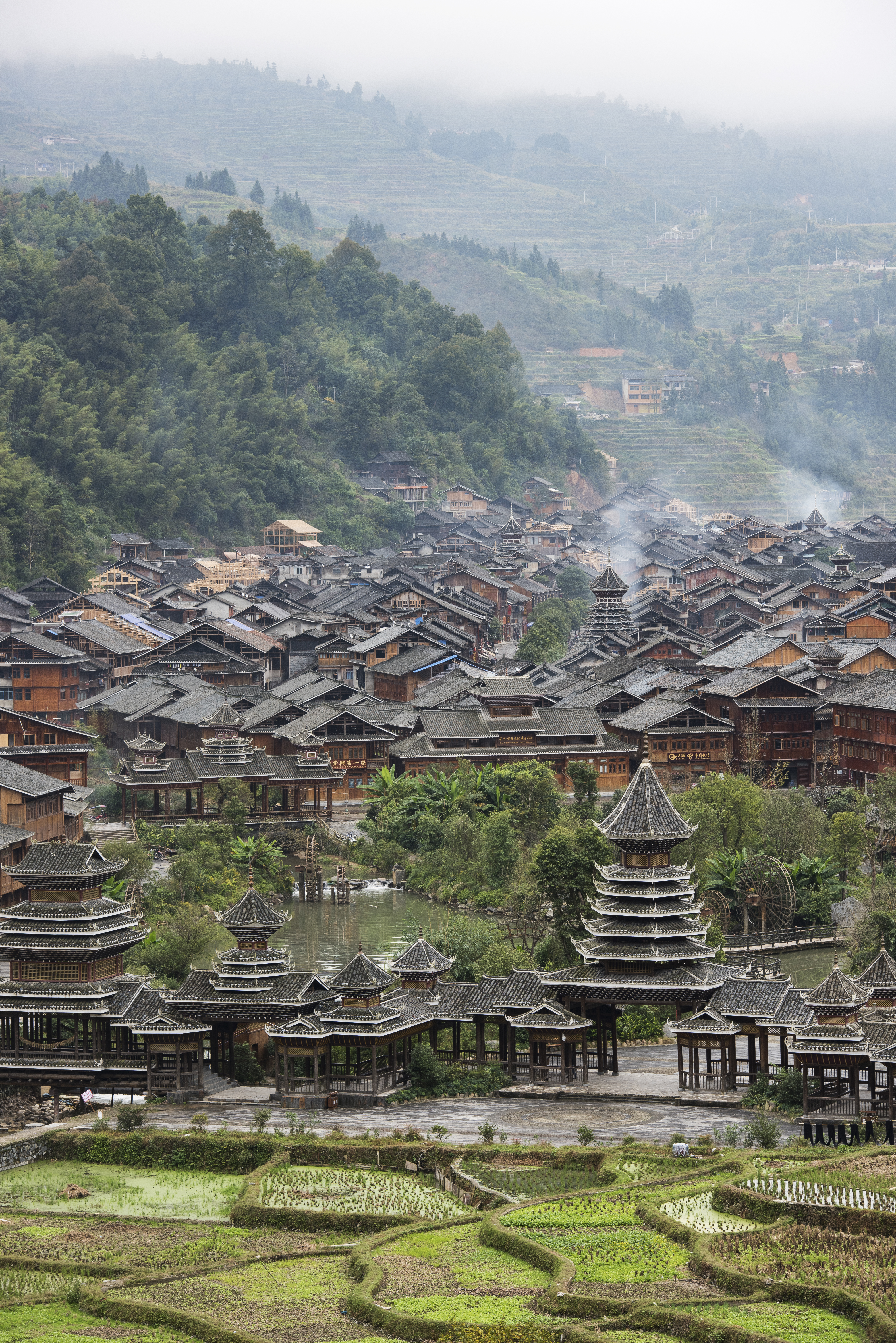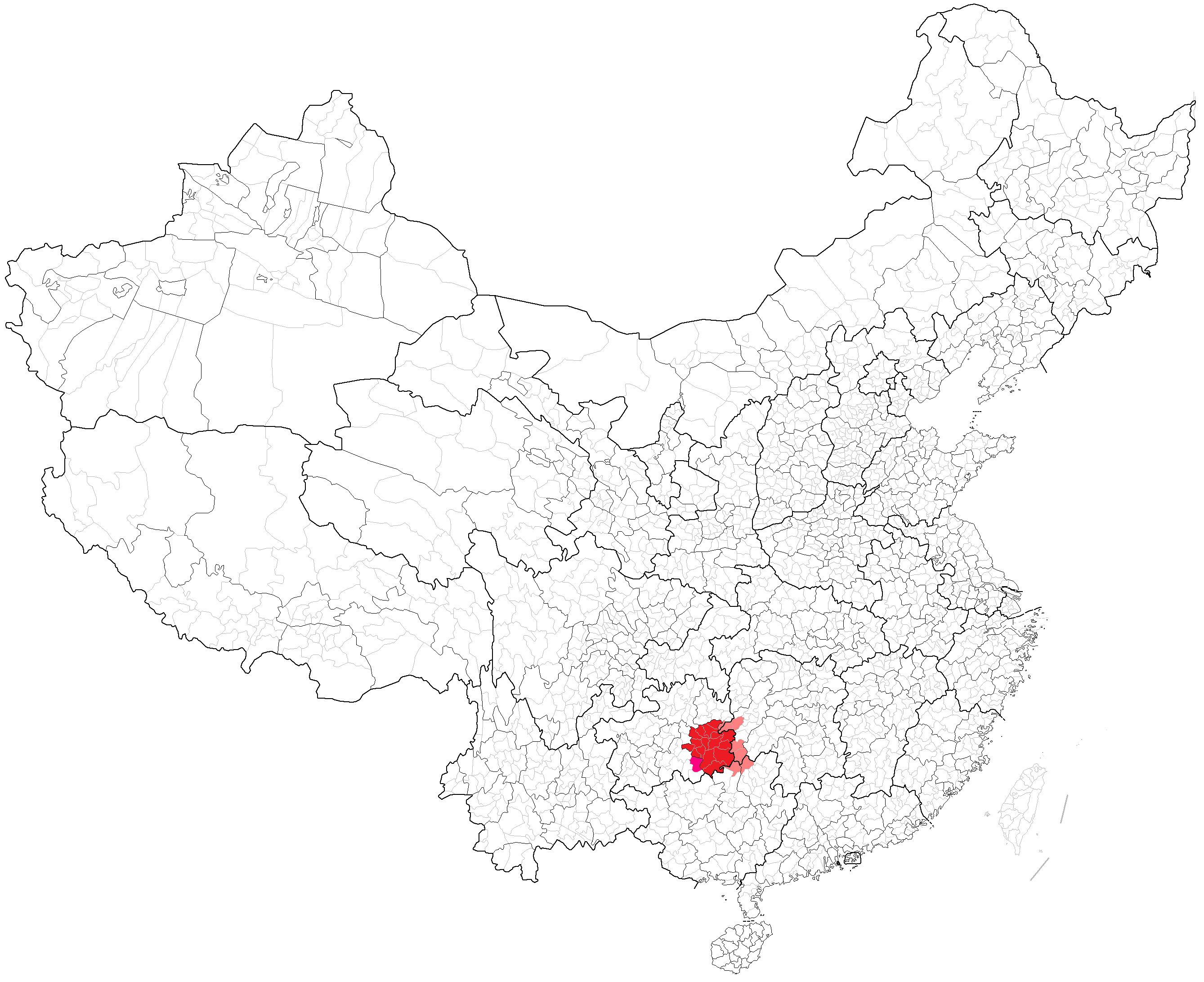|
Zhaoxing, Guizhou
Zhaoxing (肇兴镇) is a town in Liping County, Guizhou, China. It comprises eleven villages. Since the beginning of the 21st century the town is visited increasingly by tourists which has brought some prosperity to the region. Zhaoxing village The seat of Zhaoxing Town is Zhaoxing village, the largest Dong minority village in China. Therefore, it is also called "No.1 Dong Village" (Zhaodong). Zhaoxing has over 800 households and more than 4,000 inhabitants (2013). Zhaoxing village contains a lot of old wooden buildings, wind- and rain bridges but is most famous for its five drum towers. According to oral history, the ancestors of Zhaoxing built the village as early as 1160 during the Southern Song Dynasty The Song dynasty (; ; 960–1279) was an imperial dynasty of China that began in 960 and lasted until 1279. The dynasty was founded by Emperor Taizu of Song following his usurpation of the throne of the Later Zhou. The Song conquered the rest .... Gallery Refere ... [...More Info...] [...Related Items...] OR: [Wikipedia] [Google] [Baidu] |
Towns Of The People's Republic Of China
When referring to political divisions of China, town is the standard English translation of the Chinese (traditional: ; ). The Constitution of the People's Republic of China classifies towns as third-level administrative units, along with for example townships (). A township is typically smaller in population and more remote than a town. Similarly to a higher-level administrative units, the borders of a town would typically include an urban core (a small town with the population on the order of 10,000 people), as well as rural area with some villages (, or ). Map representation A typical provincial map would merely show a town as a circle centered at its urban area and labeled with its name, while a more detailed one (e.g., a map of a single county-level division) would also show the borders dividing the county or county-level city into towns () and/or township () and subdistrict (街道) units. The town in which the county level government, and usually the division's main ... [...More Info...] [...Related Items...] OR: [Wikipedia] [Google] [Baidu] |
People's Republic Of China
China, officially the People's Republic of China (PRC), is a country in East Asia. It is the world's most populous country, with a population exceeding 1.4 billion, slightly ahead of India. China spans the equivalent of five time zones and borders fourteen countries by land, the most of any country in the world, tied with Russia. Covering an area of approximately , it is the world's third largest country by total land area. The country consists of 22 provinces, five autonomous regions, four municipalities, and two Special Administrative Regions (Hong Kong and Macau). The national capital is Beijing, and the most populous city and financial center is Shanghai. Modern Chinese trace their origins to a cradle of civilization in the fertile basin of the Yellow River in the North China Plain. The semi-legendary Xia dynasty in the 21st century BCE and the well-attested Shang and Zhou dynasties developed a bureaucratic political system to serve hereditary monarchies, or dyna ... [...More Info...] [...Related Items...] OR: [Wikipedia] [Google] [Baidu] |
Guizhou
Guizhou (; formerly Kweichow) is a landlocked province in the southwest region of the People's Republic of China. Its capital and largest city is Guiyang, in the center of the province. Guizhou borders the autonomous region of Guangxi to the south, Yunnan to the west, Sichuan to the northwest, the municipality of Chongqing to the north, and Hunan to the east. The population of Guizhou stands at 38.5 million, ranking 18th among the provinces in China. The Dian Kingdom, which inhabited the present-day area of Guizhou, was annexed by the Han dynasty in 106 BC. Guizhou was formally made a province in 1413 during the Ming dynasty. After the overthrow of the Qing in 1911 and following the Chinese Civil War, the Chinese Communist Party took refuge in Guizhou during the Long March between 1934 and 1935. After the establishment of the People's Republic of China, Mao Zedong promoted the relocation of heavy industry into inland provinces such as Guizhou, to better protect them fr ... [...More Info...] [...Related Items...] OR: [Wikipedia] [Google] [Baidu] |
Qiandongnan Miao And Dong Autonomous Prefecture
Qiandongnan Miao and Dong Autonomous Prefecture (; Hmu language: ''Qeef Dongb Naif Dol Hmub Dol Gud Zid Zid Zeb''; Kam language: ''Qeens Donc Nanc Nyenc Miiul Nyenc Gaeml Zil Zl Zous''), also known as Southeast Qian Autonomous Prefecture of Miao and Dong () and can be shortened as S.E. Qian Prefecture (), is an autonomous prefecture in the southeast of Guizhou province in the People's Republic of China, bordering Hunan to the east and Guangxi to the south. The seat of the prefecture is Kaili. Qiandongnan has an area of . The whole state governs 1 city of Kaili and 15 counties. There are 7 streets, 94 towns, and 110 townships (including 17 ethnic townships). There are 33 ethnic groups living in the territory, including Miao, Dong, Han, Buyi, Shui, Yao, Zhuang, and Tujia. According to the seventh census data in China, as of 00:00 on November 1, 2020, the resident population of Qiandongnan Miao and Dong Autonomous Prefecture was 3,758,622. Demographics As of 2018, Qiandongnan had a ... [...More Info...] [...Related Items...] OR: [Wikipedia] [Google] [Baidu] |
Town (China)
When referring to political divisions of China, town is the standard English translation of the Chinese (traditional: ; ). The Constitution of the People's Republic of China classifies towns as third-level administrative units, along with for example townships (). A township is typically smaller in population and more remote than a town. Similarly to a higher-level administrative units, the borders of a town would typically include an urban core (a small town with the population on the order of 10,000 people), as well as rural area with some villages (, or ). Map representation A typical provincial map would merely show a town as a circle centered at its urban area and labeled with its name, while a more detailed one (e.g., a map of a single county-level division) would also show the borders dividing the county or county-level city into towns () and/or township () and subdistrict (街道) units. The town in which the county level government, and usually the division's mai ... [...More Info...] [...Related Items...] OR: [Wikipedia] [Google] [Baidu] |
Liping County
Liping County () is a county in the southeast of Guizhou province, China, bordering Hunan to the east and Guangxi to the southeast. It is part of the Qiandongnan Miao and Dong Autonomous Prefecture. History The county was affected by the Miao rebellion of 1736-36. The county is home to many Dong people. *1322 (years to two years) set up a long lawsuit in Liping. The Liping government started to set up in 1413 to 1913, with a history of 500 years. *In 1283, eighty thousand people in the ancient state of the military and civilian (ancient state, this Leigh Bing Rory). To rule for two years (in 1322), the abolition of Zongguan Fu, Li Ping Village renamed Liping Zhai, in Ping lawsuit change Liping lawsuit, jurisdiction over 12 executive our, Huguang province state think appease our thought state, this cengong), Li Pingshi name. *On 1385, the abolition of Liping long lawsuit, built five Wei command division, military duct, administer 15 2 villages, 14 executive secretary. Ming Yongle e ... [...More Info...] [...Related Items...] OR: [Wikipedia] [Google] [Baidu] |
China
China, officially the People's Republic of China (PRC), is a country in East Asia. It is the world's most populous country, with a population exceeding 1.4 billion, slightly ahead of India. China spans the equivalent of five time zones and borders fourteen countries by land, the most of any country in the world, tied with Russia. Covering an area of approximately , it is the world's third largest country by total land area. The country consists of 22 provinces, five autonomous regions, four municipalities, and two Special Administrative Regions (Hong Kong and Macau). The national capital is Beijing, and the most populous city and financial center is Shanghai. Modern Chinese trace their origins to a cradle of civilization in the fertile basin of the Yellow River in the North China Plain. The semi-legendary Xia dynasty in the 21st century BCE and the well-attested Shang and Zhou dynasties developed a bureaucratic political system to serve hereditary monarchies, or dyna ... [...More Info...] [...Related Items...] OR: [Wikipedia] [Google] [Baidu] |
National Bureau Of Statistics Of The People's Republic Of China
The National Bureau of Statistics (), abbreviated as NBS, is an deputy-cabinet level agency directly under the State Council of the People's Republic of China. It is responsible for collection, investigation, research and publication of statistics concerning the nation's economy, population and other aspects of the society. Ning Jizhe is the commissioner of the bureau since 2016. Responsibilities The bureau's authority and responsibilities are defined in ''China's Statistics Law''. It is responsible for the research of the nation's overall statistics and oversee the operations of its local counterparts. Organizations The bureau is led by a commissioner, with several deputy commissioners (currently four), a chief methodologist, a chief economist, and a chief information officer. It is composed of 18 departments, oversees 12 affiliated institutions and manages 32 survey organizations stationed in respective provinces. It also operates China Statistics Press. The national bu ... [...More Info...] [...Related Items...] OR: [Wikipedia] [Google] [Baidu] |
GEO (magazine)
''GEO'' is a family of educational monthly magazines similar to the ''National Geographic'' magazine. It is known for its detailed reports and pictures. History and profile The first edition appeared in Germany in 1976. Since then, the magazine has been published in Bulgaria, Croatia, Czech Republic, Estonia, Finland, France (first international edition), Greece, Hungary, India (publication ceased in 2013), Italy, Japan, Korea, Lithuania, Latvia, Romania, Russia (publication ceased in 2018), Slovakia, Slovenia, Spain, and Turkey. The current circulation figure in France and Germany is over 500,000. ''GEO'' is published by Gruner + Jahr, a publishing house owned by Bertelsmann. The French edition was launched in 1979 and is published monthly by Prisma Presse. The German version has several special editions (line extensions): ''GEO Saison'', a multi thematic magazine dedicated to tourism, ''GEO Special'' a mono thematic magazine about individual countries or cities, ''GEO Wissen' ... [...More Info...] [...Related Items...] OR: [Wikipedia] [Google] [Baidu] |
Kam People
The Kam people, officially known in China as Dong people (; endonym: , ), a Kam–Sui people of Southern China, are one of the 56 ethnic groups officially recognized by the People's Republic of China. They are famed for their native-bred ''Kam Sweet Rice'' (), carpentry skills and unique architecture, in particular a form of covered bridge known as the "wind and rain bridge" (). The Kam people live mostly in Eastern Guizhou, Western Hunan and Northern Guangxi in China. Small pockets of Kam speakers are found in Tuyên Quang Province in Vietnam. The Kam people call themselves Kam, Geml, Jeml or Gaelm. History The Kam are thought to be the modern-day descendants of the ancient Liáo (僚) peoples who occupied much of southern China.D. Norman Geary, Ruth B. Geary, Ou Chaoquan, Long Yaohong, Jiang Daren, Wang Jiying (2003). ''The Kam People of China: Turning Nineteen''. (London / New York, RoutledgeCurzon 2003). . Kam legends generally maintain that the ancestors of the Kam migrate ... [...More Info...] [...Related Items...] OR: [Wikipedia] [Google] [Baidu] |
Drum Tower (Asia)
A drum tower () or gulou is a tower in the center of an old Chinese city or village, housing signal drums. There was usually also a bell tower nearby. There were once found all over China in villages, marking the symbolic center of the settlement and used to mark nightfall and to summon the people for civic ceremonies and significant occasions, such as Chinese New Year. The drum tower often being located in the symbolic center of a city, downtown districts of several Chinese cities have been named after the tower. See also * Drum tower (Chinese Buddhism), a different type of drum tower Individual drum towers * Gulou and Zhonglou (Beijing) (Drum Tower and Bell Tower of Beijing) * Drum Tower of Xi'an * Drum Tower of Nanjing * Bianjing Drum Tower The Bianjing Drum Tower, also known as the Bianjing Pavilion and by its Chinese name as the Bianjing Lou, is a drum tower in Shangguan, the seat of Dai County, Xinzhou Prefecture, Shanxi, in the People's Republic of China. It dates t ... [...More Info...] [...Related Items...] OR: [Wikipedia] [Google] [Baidu] |
Song Dynasty
The Song dynasty (; ; 960–1279) was an imperial dynasty of China that began in 960 and lasted until 1279. The dynasty was founded by Emperor Taizu of Song following his usurpation of the throne of the Later Zhou. The Song conquered the rest of the Ten Kingdoms, ending the Five Dynasties and Ten Kingdoms period. The Song often came into conflict with the contemporaneous Liao, Western Xia and Jin dynasties in northern China. After retreating to southern China, the Song was eventually conquered by the Mongol-led Yuan dynasty. The dynasty is divided into two periods: Northern Song and Southern Song. During the Northern Song (; 960–1127), the capital was in the northern city of Bianjing (now Kaifeng) and the dynasty controlled most of what is now Eastern China. The Southern Song (; 1127–1279) refers to the period after the Song lost control of its northern half to the Jurchen-led Jin dynasty in the Jin–Song Wars. At that time, the Song court retreated south of the ... [...More Info...] [...Related Items...] OR: [Wikipedia] [Google] [Baidu] |






